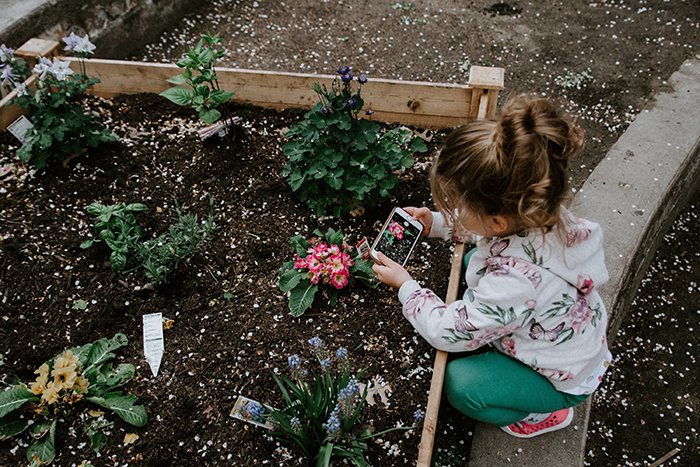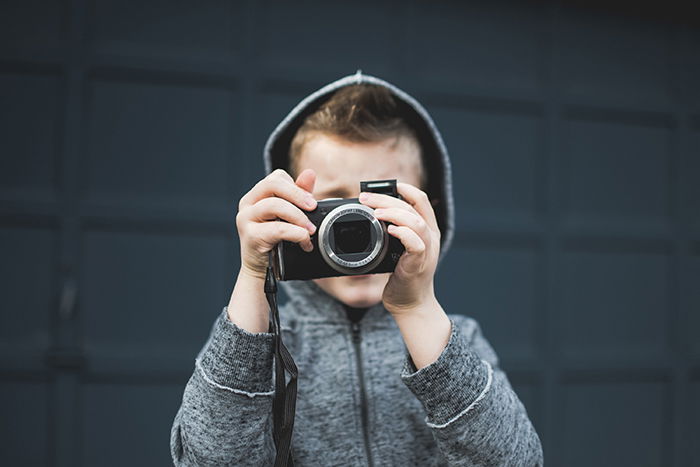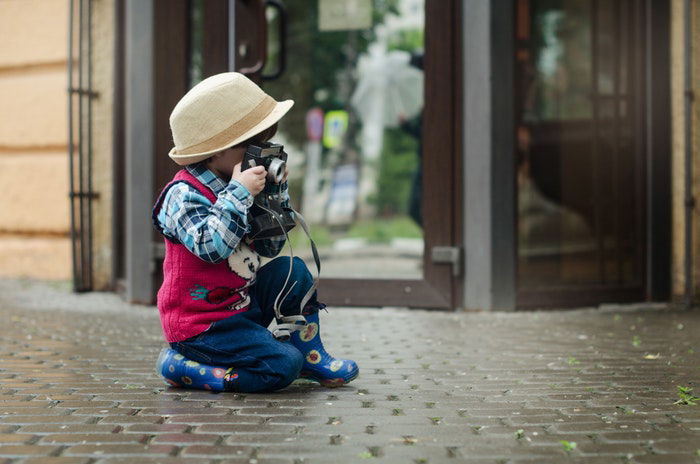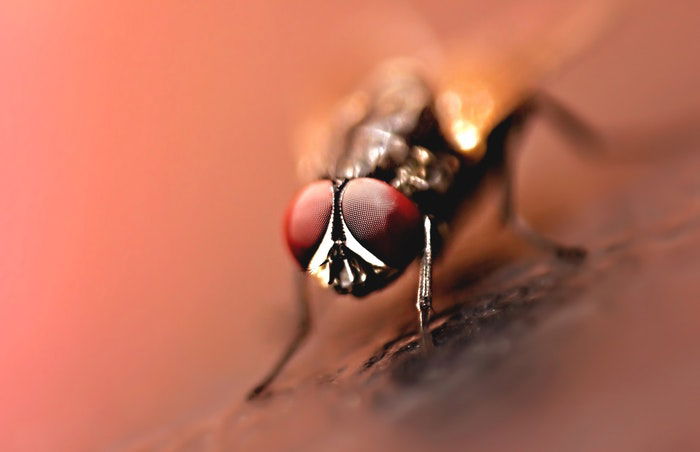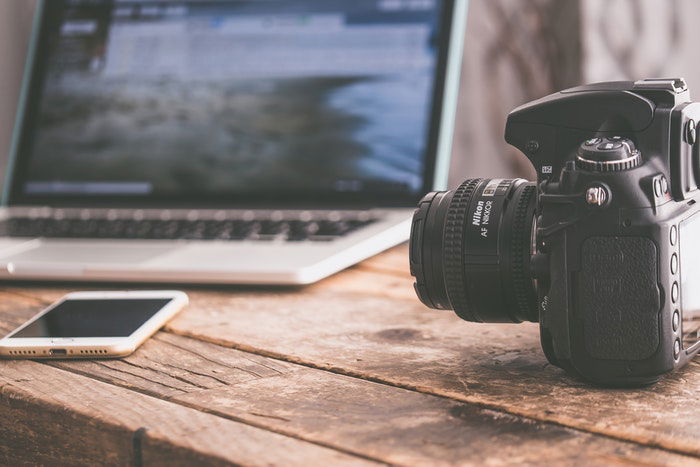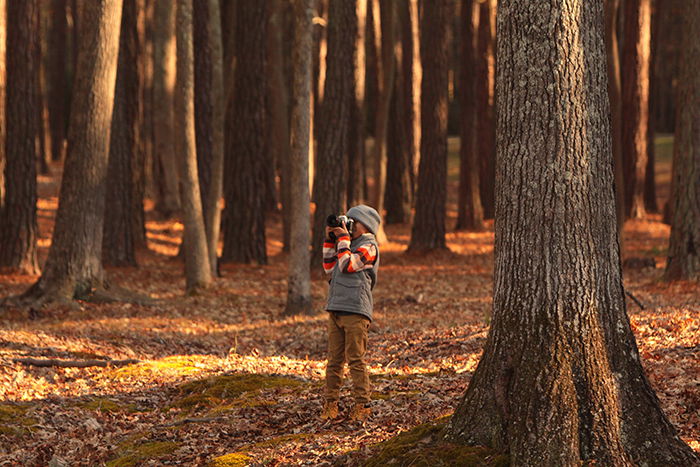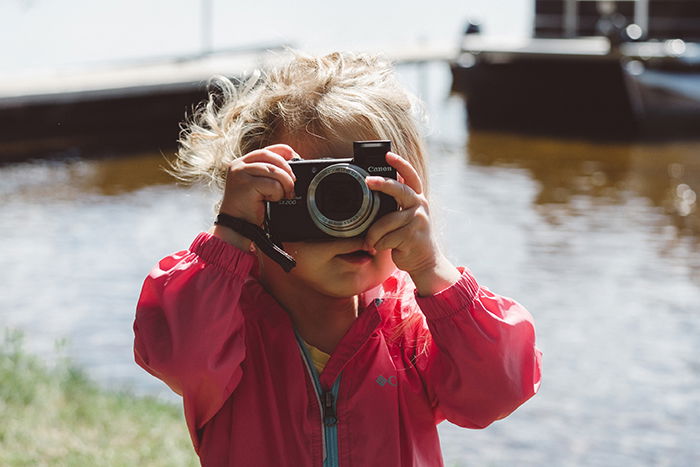Chances are, adults already have an idea of what a good photograph is supposed to look like. This sets the bar too high from the start. But kids? Kids are naturally curious and expressive. They don’t yet have the creativity-squashing rules in their minds. Teaching photography for kids is less about learning rules. It’s more about allowing creativity to blossom. You might want to create formal photography classes for kids or teach your child the joys of photography. No matter which one is you, here are 15 valuable lessons to teach photography for kids.
Photography for Kids: Lessons to Learn
Camera Care
Simply owning a camera is a lesson in itself — how do you care for that camera? Once a child has a camera, teach them how to care for the camera. Kids should be instructed not to drop the camera and to keep it in a safe spot when not in use. It’s a great idea to also teach kids to use a lens cloth to wipe the front. You should also show them how to charge the batteries and how to upload the photos to a computer.
Grip
Holding a camera isn’t just about grabbing the camera in whatever way is comfortable. A proper grip will help reduce camera shake, while allowing easy access to the rest of the camera’s controls. Teach kids to wrap their bottom three fingers around the camera grip, with their index finger on the shutter and the thumb at the back. With larger cameras, the left hand should go under the lens to help support that weight. Another good grip tip for kids? Use the neck or wrist strap to avoid dropping the camera by accident.
Creativity
In today’s rigid academic schedule, children often have even their drawings and artwork graded. Take a different approach with photography for kids. Let the child know that photography is about being creative and showing other people how you see. Encourage that creativity, even if it means breaking the “rules.” Tell them what you love about the photo. Then, instead of telling them what you hate about the photo, encourage them by using “what ifs.” For example, what if you laid on your belly to photograph that flower instead of standing over it? What if you placed the flower off to the side of the picture instead of in the center? Rather than criticizing, help them see the possibilities.
Exploration
Many photographers — of any age — learn through experimenting. With digital, there’s little consequence to trying something one way, then a different way. Kids who learn by experimenting often remember that information better than verbal instruction alone. With digital cameras, there’s no film that’s wasted and you can delete an image with a few clicks. Encourage kids to try more than one way to take that photo. A great exercise to encourage kids to explore with their camera is to hand them an object. Ask them to take ten photos of that object that are all different. If they get stuck, help them think of other options. These might be changing the perspective, moving the object to a new location, or adjusting the camera settings.
Practice
Along those same lines, digital photography means that little is wasted when practising photography. Encourage the child to take another shot to try to fix what they didn’t like the first time. Cameras that kids can use without supervision — i.e. something that’s not expensive or overly complicated — are great. Kids can practice with them anytime. They can even take them places to photograph whatever inspires them as they go through their day.
Subject
The subject is one of the most basic and essential pieces of photography. Most kids understand, even innately, that a photo should have an object or person in it. Talk to them about what is in the photograph and what’s in the photograph that’s the most important. Introduce the term “subject” and ask them to think of other ways to photograph that same subject.
Perspective
Photography is a way of seeing — the camera helps young photographers show others their view of the world. Offer tips on perspective when teaching photography to kids. Especially if they only photograph everything at eye level. Encourage them to shoot while lying on the ground or standing on tiptoes. Suggest they try shooting the subject from another side.
Zoom
Changing your angle isn’t the only way to adjust perspective. First, teach your child how to use the zoom that’s on the camera to make objects closer or farther away. Then, make sure kids know they can zoom with their feet too. Getting closer or farther away from the subject is another way to change perspective. While teaching zoom, encourage them to explore macro photography too. A fun exercise in macro photography is to ask them to take pictures of objects up close. See if you can guess what those objects are. Be sure to also show them how to turn on the macro mode on the camera too.
Detail
An eye for detail is a great thing to have as a photographer. Encourage them to slow down before they take the picture. Is the camera being held straight? Is the subject crooked? Is there a random, distracting object in the photo that could be removed? This is a great time to each young photographers to look for distractions in the background too. Make suggestions on looking for distracting objects that could be left out with an adjustment in the perspective and zoom. Help them see awkward background placement. For example, a telephone pole sprouting out of the subject’s head. A great exercise to teach this is to try the opposite. Ask them to take funny pictures where their stuffed animal is wearing funny “hats”. These are objects in the background that appear to pop out of its head.
Storytelling
A photograph tells a story. Look over the child’s photos, and ask them to tell you a story about what’s going on in the photo. This exercise helps kids recognize that photographs tell a story.
Composition
By default, most kids tend to put everything in the center of the photo. There are also kids who will put subjects so far on the edge of the image that the object or person is cut off entirely! Start teaching kids composition by introducing the idea of placing the object somewhere else in the photograph. You can introduce this idea by taking your own photos of the same subject with a different composition. Another popular photography exercise for kids is to give them a picture frame with no glass or back. Ask them to “frame” objects around the house in different ways. This photography exercise that doesn’t even require a camera.
Focus
When you first give a child a camera, they will be using the auto area autofocus mode. As kids build a basic grasp of photography, show them single point autofocus mode (if their camera has one). Here they can select where the camera focuses using the arrow keys on the back of the camera. Place two objects on a table, one close to the camera and one farther away. Have them move the focal point over one, then the other, refocusing each time. This is a great way to introduce how focus varies based on distance.
Mode
Before teaching a child about exposure, teach them that there are different modes on the camera for different types of shoots. Show them sports mode for action shots and macro mode for close-ups. Show them both how to change the mode on the camera, and what each mode is best for. This helps build a foundation for learning exposure.
Exposure
Kids with a firm grasp of basic photography concepts can even start diving into learning about exposure. Teach one aspect of exposure at a time — diving straight into manual mode is overwhelming, even for adults. Use simple language and lots of practice. Shutter speed: A visual aid may help teach kids shutter speed. Show a movie of a camera shutter at work. Explain how the shutter is a door that opens to take the picture and anything that moves while that door is open will blur. Find a moving object, like the family dog or a fan. Take a photo with a fast shutter speed and a slow shutter speed to show this. Encourage practice using shutter priority mode. Aperture: Visuals are helpful here too. Go outside on or before a rainy day with a narrow glass and a wide bucket. Ask him which one he thinks will collect more rain — then wait and see if he’s right. Explain that, like a wider bucket gathers more water, a wider aperture gathers more light. Then, introduce the concept of depth of field. Ask them to take a photo at a wide aperture and then the same photo at a narrow aperture. Compare how the background in the two images looks.
Art
Photography for kids can also build an appreciation of art in general. Besides encouraging kids to take photos, encourage them to look at photos too. Go to an art museum and talk about the images or Google images of some of their favorite places or things. Talk about the images, about why they like them or why they don’t. You can discuss the photography concepts that you’ve already introduced as well.
Common Questions About Photography for Kids
What Do Photography Classes Teach?
Photography classes teach students how to use a camera. And how to turn the idea in their mind into a physical photograph. Some common topics include exposure, focus, editing, and more.
What Do You Learn in Digital Photography?
In a digital photography class, you’ll learn the essentials. These include shutter speed, aperture, ISO, focus modes and more. With digital photography, you’ll also learn how to see the beauty in a scene to create an image.
What Is the Best Beginner Camera for a Child?
The best beginner camera for a child is a camera that’s durable, easy to use, and offers different shooting modes. Waterproof cameras are great for kids because they are hard to destroy. An older child may do well with a used, inexpensive DSLR or mirrorless camera. The best digital camera for a teenager is often an entry-level mirrorless or DSLR camera.
What Do You Teach Kids About Photography?
Teaching kids concepts such as exposure and composition is great. The biggest thing to remember when teaching photography for kids is to encourage them to be creative and show their view of the world. Conclusion Teaching kids photography doesn’t just give them the skills to take a good photograph. Photography helps kids to exercise their creative muscle and encourages exploration. It builds valuable visual and critical thinking skills for later in life. When teaching kids photography, start slow and use plenty of encouragement. Build on each skill, moving on at a whatever pace works for the child’s skill level. Encourage practice with photography exercises or by giving them time with a camera.
